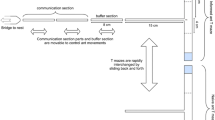Summary
A method is described by which information from odors specific to the vicinity of forager stations can be separated from symbolic dance-language information. Under these conditions, most recruits use the symbolic cues. A series of distance experiments is reported in which mean recruit accuracy was found to be ±11–12%. When Wenner's training technique was used, recruit accuracy fell to ±36%. When von Frisch's techniques were used, recruit accuracy rose slightly to ±9%. The implications of these results for the dance-language controversy are discussed.
Similar content being viewed by others
References
Esch, H.: Über die Schallerzeugung beim Werbetanz der Honigbiene. Z. vergl. Physiol.45, 1–11 (1961)
Free, J. B.: Influence of the odour of a honey bee colony's food stores on the behaviour of its foragers. Nature (Lond.)222, 778 (1969)
Free, J. B.: Effect of flower shapes and nectar guides on the behaviour of foraging honey bees. Behaviour37, 269–285 (1970)
Frisch, K. v.: Die Tänze der Bienen. Österr. Zool. Z.1, 1–48 (1946)
Frisch, K. v.: The dance language and orientation of bees. Cambridge,Mass.: Harvard Univ. Press (1967a)
Frisch, K. v.: Honey bees: do they use the direction and distance information provided by their dancers? Science158, 1072–1076 (1967b)
Frisch, K. v., Jander, R.: Über den Schwänzeltanz der Bienen. Z. vergl. Physiol.40, 239–263 (1957)
Gary, N. E., Witherell, P. C.: A method for training honey bees to forage at feeding stations. Ann. Entomol. Soc. Am.64, 448–449 (1971)
Gould, J. L.: Honey bee communication. Nature (Lond.)252, 300–301 (1974)
Gould, J. L.: Honey bee recruitment: the dance-language controversy. Science,189, 685–693 (1975a)
Gould, J. L.: Honey bee communication: the dance-language controversy. Thesis, Rockefeller University (1975b)
Gould, J. L., Henerey, M., MacLeod, M. C.: Communication of direction by the honey bee. Science169, 544–554 (1970)
Heran, H.: Wahrnehmung und Regelung der Flugeigengeschwindigkeit beiApis mellifica. Z. vergl. Physiol.42, 102–163 (1959)
Johnson, D. L.: Honey bees: do they use the direction information contained in their dance manoeuver ? Science155, 844–847 (1967)
Johnson, D. L., Wenner, A. M.: Recruitment efficiency in honey bees: studies on the role of olfaction. J. Apicult. Res.9, 13–18 (1970)
Lindauer, M., Schricker, B.: Über die Funktion der Ocellen bei den Dämmerungsflügen der Honigbiene. Biol. Zbl.82, 721–725 (1963)
Renner, M.: Über ein weiteres Versetzungsexperiment zur Analyse des Zeitsinnes und der Sonnenorientierung der Honigbiene. Z. vergl. Physiol.42, 449–483 (1959)
Schricker, B.: Die Orientierung der Honigbiene in der Dämmerung. Z. vergl. Physiol.49, 420–458 (1965)
Wenner, A. M.: A method of training bees to visit a feeding station. Bee World42, 8–11 (1961)
Wenner, A. M.: Sound production during the waggle dance of the honey bee. Anim. Behav.10, 79–95 (1962)
Wenner, A. M.: Honey bees: do they use the distance information contained in their dance manoeuver ? Science155, 847–849 (1967)
Wenner, A. M.: The bee language controversy. Boulder, Colorado: Educational Products Improvement Corp. (1971)
Wenner, A. M., Johnson, D. L.: Honey bees: do they use the direction and distance information provided by their dancers? Science158, 1076–1077 (1967)
Wenner, A. M., Wells, P. H., Rohlf, F. J.: Analysis of the waggle dance and recruitment in honey bees. Physiol. Zool.40, 317–344 (1967)
Wells, P. H., Wenner, A. M.: Do honey bees have a language? Nature (Lond.)241, 171–174 (1973)
Wilson, E. O.: The insect societies. Cambridge, Mass.: Harvard Univ. Press 1971
Author information
Authors and Affiliations
Additional information
I thank N. E. Gary for valuable technical advice, M. Rossetto for designing the electronic circuits, R. O'Connell for obtaining the scents, P. Marler, B. Hölldobler, F. Nottebohm, and especially D. R. Griffin for advice and criticism. This work was supported in part by the Mary Flagler Cary Charitable Trust, Millbrook, New York.
Rights and permissions
About this article
Cite this article
Gould, J.L. Communication of distance information by honey bees. J. Comp. Physiol. 104, 161–173 (1975). https://doi.org/10.1007/BF01379457
Received:
Issue Date:
DOI: https://doi.org/10.1007/BF01379457




